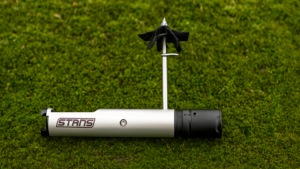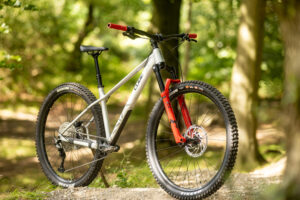Longtermer: YT-Industries Wicked 150
March 2012
I got an email the other day from an old mate. The subject line simply read ‘Munter’. I immediately assumed he was talking about his latest Saturday night conquest. But no, the fugly swamp donkey to which he was referring was my longtermer. Now the YT is no oil painting (it’s definitely more post modern abstract impressionism), but to label it a munter was going a bit far. Under all that multi-coloured slap there’s actually a mighty fine bone structure.
OK, so I wasn’t convinced at first. But this was mainly because the RockShox Revelation RLT fork rode so deep into its travel at the recommended pressures that the whole bike felt completely unbalanced. The front end was too low, the head angle too steep and the fork would bottom out as soon as the trail tilted downhill. Incrementally I increased the pressure in the positive chamber until I had achieved a more favourable dynamic sag. Unfortunately the pressure I ended up with was 160psi, which RockShox recommends for a 90kg rider, leaving the small bump sensitivity a little anaesthetized. I’m going to see whether RockShox has a fix for this, but in the mean time I’ll have to put up with a bit of a harsh front end to keep the geometry shipshape.
When I first pulled the Wicked out of the box, the rear shock felt very sticky. But with 100 miles under the belt, it’s loosened up nicely. There’s very little range offered by the rebound adjuster, but what’s there doesn’t leave me wanting for more, or less damping.
Finally, rare though my YT is on these shores, it is not alone. A few days after writing my first longtermer instalment, I spotted another Wicked pounding the Surrey Hills. It belonged to Marcus Gange and he’s had the bike since last summer. Initially he had a few problems with the forks, but they were replaced under warranty. Since then his dealings with YT have been limited to asking for some clips for his dropper post remote (which were posted out without charge). A shorter stem and wider bars are his only other upgrades, both items I’m considering for later in the year, but for now I’m happy to keep my YT stock.
April 2012
Not wanting to let my 2012 longtermer become a protracted soap opera of exchanging fork internals (eh, Darlow?!), I’ve sent my RockShox Revelation RLT Dual Position off to SRAM for a bit of fettling. By leaving it to the pros I’m hoping to avoid my YT hanging limbless on a meat hook for months while it gets sorted, and maximise my riding time on the new improved version. Conversing with SRAM revealed that the Dual Position Revelation has a more linear spring curve than the Dual Air version, a trait that is preferred by the German market. Our Continental cousins like to slam their forks for those three-hour fireroad climbs, followed by something nice and plush for those long, er, fireroad descents. OK, so that’s being a bit unfair, but I can see why YT has specced the Dual Position version when most of its sales will come from the Bundesland. That doesn’t help my situation, however, so SRAM is kindly offering to change the characteristics of the fork to, hopefully, suit my preferences. In a nutshell it’s going to reduce the size of the air chamber, which will increase the progressiveness of the spring. Sounds promising, and all being well, I’ll be able to let you know next month whether the modification has worked.
May 2012
My forks are back from SRAM, but the modifications were not quite what I’d anticipated. Initially we’d discussed reducing the size of the air chamber to alter the spring curve. I wanted more progression without compromising too much on small bump performance, and tweaking the spring curve looked like a pretty good solution. As it turns out, it wasn’t possible to shrink the chamber without ruining the overall performance, so SRAM put the Revelation back together in its original form and sent it back to me with a few set-up suggestions.
The new settings recommended book pressures for the air spring, mid-way on the low-speed compression damping and two-clicks from fully open on the Floodgate. Theoretically, this should add support via the damper to reduce the tendency to dive at lower pressures, while keeping the harshness at bay. I haven’t had a proper chance to ride the fork yet, or play with the settings, but I’ll let you know next month what effect they’ve had.
Just before the fork got sent away, I got hold of a new chain guide that comes standard on the 2012 YT-Wicked. It’s a dangler-style tensioner, made by Bionicon, which hangs from the gear cable outer casing beneath the chainstay. Simple and lightweight, it seems to work pretty good. Shifting is still smooth and quiet, and I haven’t experienced a dropped chain since it went on. I’m still a little sceptical about using the cable outer casing to support it, as a couple of zip ties would seem the obvious choice, but so far it’s getting my thumbs up.
And talking of the 2012 bikes, I’ve had a few people ask why I’m not on one of the newer models shown under ‘Preview’ on the YT-Industries website. The answer is simple and it all comes down to availability. With the first shipment of new models only due to arrive in Europe around the time you read this, it simply wasn’t possible to get one in time for our first longtermer deadline.
Most of the changes centre on the spec anyway, with the addition of a 10-speed drivetrain, the aforementioned chain guide and a smattering of Race Face and DT Swiss components. Unfortunately the price has crept up a little, to €1899, but considering the spec, it’s still a steal.

Bionicon chain device simple but effective/fork settings now dialled/outer ring removed to make way for bash ring
June 2012
The opportunity to knock seven shades of sheep sh… you know what out of my YT rarely presents itself locally, but on a recent trip to the South Wales Valleys the Wicked received its due punishment. The sentence: an afternoon squaring up to the roots, rocks, stumps and jumps of this old Dragon downhill track.
So how did it cope? Well, hand on heart, I’m extremely impressed, and we’ve entered a new era in our relationship. Climbing to the top was pleasantly efficient considering the bike’s weight and travel. Turn the pedal platform on, dial in some compression damping on the fork and it’ll churn its way to the top with very little wasted energy.
But it’s with the saddle down and the dials off that it really performs. I’ve always thought YT has done a wicked job with the geometry, but clattering down a Welsh mountain really cemented that view for me. The slack head angle combined with a decent wheelbase length and reasonably low bottom bracket made for a stable companion at high speeds, and I found my confidence swelling rapidly on the bald slopes of the upper mountain.
There’s a stepdown as the track enters the trees, enough to buck a trail bike into the bracken, but the YT suspension feels great deeper into its stroke, staying settled enough for only a light tap on the brakes before hitting a maelstrom of roots and loose rock. The new fork settings recommended by SRAM are also doing their job very well, bringing mid-stroke support without the initial harshness I was experiencing at higher pressures.
Handling is everything on the lower third of the Mountain Ash track, with frequent changes of direction, often coming shortly before or after getting airborne. It’s fair to say the YT isn’t the nimblest of movers, but I have a theory this is more to do with the suspension than the geometry. While it copes well with bigger hits, the suspension definitely lacks suppleness and, as a result, it neither has the grip nor the pop that often goes hand in hand with brilliant small bump performance. Let momentum carry it over the gaps and be fluid with your movements and it’s impressive what it can take on, but the reward for the rider is not as rich as perhaps it could be.
Which has led my attention to move back to the shock again. Initially I complained about the Monarch RT3 shock being sticky out of the box, and although it freed up with a few miles under its belt, I’m back to thinking it’s over-damped on the compression side. The ‘H’ for high compression tune on the air can certainly adds weight to my argument, so my next step is to try and get hold of a lighter tuned Monarch to see if this helps soak up the pitter-patter and provide a little bit of sparkle to a machine that is brimming with ruthless Teutonic efficiency




















